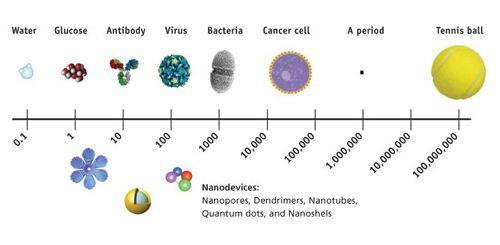My brother Greg, Co-Owner of DI, mentioned that some detailing supplies are marketing themselves as “nano” or as having “nano” particles, so he reached out to me to see if I could shed more light on the topic. I currently work at one of the world’s leading nanotechnology research and development facilities.
The term nano is used to brand or market many products including music playing devices, cleaning products, clothing, and so much more. Today there are well over 1,000 manufacturer identified nano based products available to consumers, but what does the term really mean? Nano is defined as a unit of measure which is one billionth of a meter (10-9m). To give a perspective on how small that actually is the scale below shows various objects on the nanometer scale. On the x axis you will find a scale running from .1 nanometers (nm) to 100,000,000nm. A water molecule which is made up of three atoms, two hydrogen atoms and one oxygen atom (H20), is approximately the size of .1nm. These are some of the smallest atoms and as you can see even when combined together don’t even make up the size of one nanometer. Other elements can be larger in size.
The nanometer scale (http://nano.cancer.gov/learn/understanding/)
As first described by Richard Feynman in 1959 nanotechnology is science, engineering, and technology conducted at the nanoscale, which is about 1 to 100 nanometers. Nanoscience and nanotechnology are the study and application of extremely small things and can be used across all the other science fields, such as chemistry, biology, physics, materials science, and engineering. Nanotechnology is not just a new field of science and engineering, it provides new approaches to problem solving in all disciplines of science (Nanotechnology Definition). Nanotechnology, as many of us think about today, is related to making electronic devices smaller while increasing their functionality. This is an extremely expensive and unforgiving business to be in. This can be seen in the $1 billion dollar lawsuit that Apple filed against Samsung. Given the fierce competition these companies expect and demand the best quality from all of the components that go into making their devices which does in part include nanomaterials. Some of the world’s largest tech based companies have had to pool their resources together to absorb the extraordinary costs of nano technology based research and development.
If you can recall back to tenth grade chemistry class there is a periodic table comprised of 118 elements. These elements by themselves are considered to be on the nano scale sized, therefore they can be classified as nanomaterials. There are highly specialized techniques to create pure nano sized particles and equipment to analyze their size and purity. Below is a picture of a nano particle taken with a scanning electron microscope (which range in cost from approximately $2.5-10 million dollars). The size of these particles can more efficiently cover surface areas making it useful for many consumer products including car detailing products, specifically cleaning products or protective coatings. Given that nano is a relatively newer field of science with a high cost of entry explains why these materials have not been previously exploited in the commercial space.
SEM image of an alumina nanoparticle (http://www.science.oregonstate.edu/~minote/wiki/lib/exe/fetch.php?media=cnt_02_contrast_500.jpg)
Although there are many perceived benefits of using nanoparticles this is an unregulated aspect of consumer products at this time in the United States. The term “nano” is not trademarked to a particular industry or product. Since it does require specialized equipment to develop and characterize these particles often time producers of products that contain nanomaterials don’t know exactly what is going into their product. In addition, some elements, which would be nano sized particles, could be used for commercial applications, including those for car detailing, typically like to aggregate (clump) together. So a product may state that it contains nanomaterials however since those particles like to clump together there is not anything actually nano sized in the product. There may be one component of a product that is classified as a “nano particle” and therefore the entire product is labeled as such as a marketing tool.
For detailing purposes the benefits can still be tremendous with the usage of nanomaterials or smaller particles even if they fall short of true definition as defined earlier in this article. Particles at the nano scale inherently function different than their larger counterparts, and these properties can be more readily exploited within improved consumer products. Using smaller particles with protective qualities, even though they may aggregate together, could still result in an improved product compared to traditional protective products (i.e. older waxes and sealants). These newer products using nano sized particles can conform in a more orderly manner, meaning an application can be thinner yet stronger. Newer protective coatings are more commonly translucent and dry clear so no removal is needed saving you time and reducing the waste of excess product. So some “nano” labeled detailing products may not actually be using “nano particles” but they still may be an improvement from older technology currently in use.
Working at a facility which is entirely dedicated to advancing the field of nano I wholly believe that nano will play a continuously larger role in our lives from new electronics, to medicine, and other consumer products. However, I think consumers should proceed with caution since nano doesn’t always mean better. In fact products branded that way may not even really have anything to do with nano.
Michelle –
